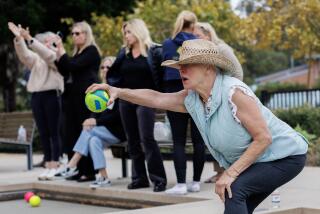Lawn Bowlers See Their Grass as Always Greener
- Share via
Eighty-year-old Bill Dietrich doesn’t just walk the land his ancestors did. He cares for it, blade by blade.
He spends 12 hours a week cutting, aerating and sanding the little-known public lawn bowling greens at Santa Ana’s Santiago Park.
Dietrich’s commitment is emblematic of most of the members of the Santa Ana Lawn Bowling Team, who, two or three times a week, practice a sport that the British brought to the American colonies. Team members also provide funds and volunteer to maintain the city park land.
“It’s a good game. You don’t know what’s going to happen until the last ball is thrown,” said Dietrich, a retired county engineer whose father and sister played on the same field he does. “Lawn bowling forgives you. You can miss a day and come back. And whoever shows up, plays.”
The team brochure advertises that the members “like to do it on the grass.”
To that end, Dietrich ensures the Bermuda is 1/8 -inch high on the pair of 120-square-foot fields that constitute the bowling areas. Each area is divided into seven lanes, known as rinks, where the balls are thrown. One rink is named for Dietrich and another is named for his father, Roscoe.
Besides nostalgia, Dietrich and his teammates see other value in the game. Lawn bowling cements the regulars -- most of whom are 65 and older -- to the concepts of precision, strategy, challenge and community, they say.
They also say lawn bowling is good exercise. A single game requires walking the 125-foot field 14 times -- the equivalent of nearly six football fields.
It’s become such a passion for Doug Horwood, 72, that he offers free lessons to anyone who will take them. He provides newcomers his brochure, “Lawn Bowls: The Trickiest Sport Ever Devised by the Mind of Man.”
After a cup of coffee and some peanut brittle made by Horwood’s wife and team member Marion Horwood, Dietrich rings a cowbell. Members salute the flag and say the Pledge of Allegiance. They conduct a blind drawing to create teams. Then they grab their individually owned balls, known as bowls, and head for the field, where the team has played since 1938.
Two can play two. Three can play three. The arrangement depends on how many people show up. On a recent week during the holidays and with a chilly wind blowing, six players divided into two teams of three. On other days, there can be as many as two dozen. And tournaments draw people from throughout the country.
The object of the game is to roll the bowls so that they stop as close as possible to a small white ball known as the jack. The bowls are a challenge to roll because they are heavier on one side and naturally curve in the direction of the weighted side. If the bowl hits the jack, it doesn’t end the game, but can change the outcome by putting it closer to another player’s bowl.
Horwood explained that lawn bowling “is like chess.”
Others chimed in to defend and explain the game.
“It’s a game that requires finesse,” said Paul Gresbrink, 62, a retiree who played football in his younger years.
It also requires the gift of gab as the players debate who’s the oldest and the best.
“She’s 100,” Horwood said as he pointed to Luella Obering, the team treasurer.
“I am not,” said Obering, whose finely manicured nails and richly colored blond hair belie her 85 years. She has three children in their 60s; six grandchildren; 14 great-grandchildren; and the possibility of a great-great grandchild.
Marion Horwood told a visitor that her husband lied when he said he made the peanut brittle. “How could he say he made the candy?” she exclaimed.
Chatter is mixed with serious play. Sort of. No one is too concerned whether they win or lose. Although that’s not always readily apparent.
Audrey Chandler, 66, a retired Santa Ana teacher and former tennis player, rolled her bowl, hoping it would stop near the jack.
“Slow down, baby. Don’t roll too much,” she beckoned. “I need you.”


